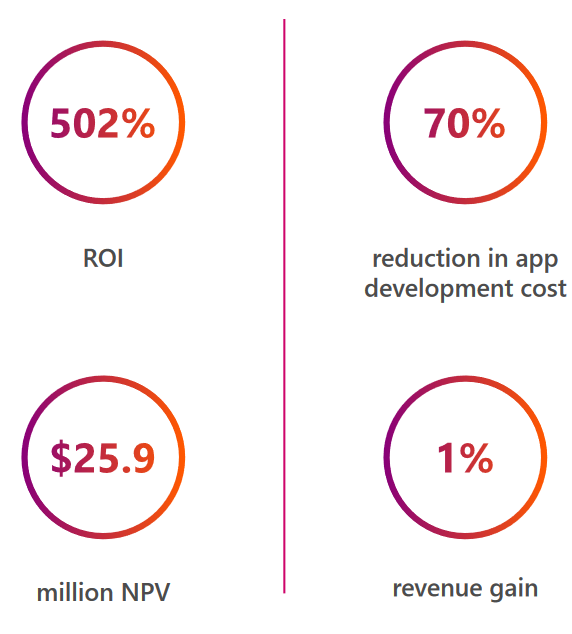In a world where digital transformation is pushing organisations to continuously evolve while resources are becoming increasingly scarce, the value that the Microsoft Power Platform can provide is invaluable. In this article, I want to take a look at how the power platform empowers companies to optimise their business processes, drive innovation and ultimately increase their business value.
No-Code/Low-Code: The Hype is real
By replacing traditional development methods with a visual approach to creating apps and workflows, no-code/low-code democratises software development and creates a broad base of so-called citizen developers among non-technical employees. These so-called “business technologists” can quickly prioritise and tackle business requirements without having to rely on an IT department. The result is a release of resources and time within the entire organisation.
How to make money: $25.9 million powered by the platform
Using Power Platform to drive business value can pay off big if you do it right.
Forrester finds that Power Platform can help streamline operations, speed development,
reduce development costs and reliance on corporate IT and boost revenues.
For a company with a turnover of 3 billion US dollars and 10,000 employees, this can lead to an ROI of 502% and a capital value of 25.9 million US dollars – with an additional ROI of 94% and a capital value of 11.4 million US dollars for the company’s IT department. App development costs can decrease by up to 70%. Annual revenue can increase by 1% and the operating margin can increase from 12% to 12.5%.
Here is why:
- Citizen developer projects completed using low-code/no-code tools cost less
- The organizations replaced third-party business applications and business intelligence tools with Power Platform
- Solutions built with Power Platform made users of all types more efficient
- Power Platform delivered improved business outcomes across many dimensions

Does Automating This Process Pack a Punch?
Not every process is worth automating. Or as we tend to say: Shit it – shit out. A bad automated process is still a bad process. Let’s compare the business value with the cost of automation.
The cost of doing nothing
What happens if we don’t solve the problem? What are the consequences of sticking with the old? This is particularly important when it comes to implementing platforms such as the Microsoft Power Platform.
As organisations define the business benefits they expect from such solutions, it is essential to take a closer look at the current costs of maintaining manual processes. Essentially, this means looking closely at the cost of doing nothing.
In order to determine the current costs, the time invested in carrying out the existing processes and the financial burden of the personnel involved must be comprehensively analysed. To obtain an annual estimate, the cost of running the process over a period of time must be extracted, taking into account variables such as frequency and additional expenses such as software licences and consumables.
Read more about the financial calculation of the automation process here.
Defining the business value
Microsoft’s Power Platform is not just another tech solution; it’s a catalyst for revenue generation and operational excellence. By harnessing its capabilities, businesses can unlock a multitude of benefits, including:
- Streamlined Operations: Automate repetitive tasks, streamline workflows, and eliminate bottlenecks to enhance efficiency.
- Cost Savings: Reduce development and maintenance costs, optimize resource allocation, and minimize operational expenses.
- Risk Mitigation: Strengthen data security measures, ensure regulatory compliance, and mitigate operational risks.
- Innovation and Adaptability: Foster a culture of innovation, empower teams to adapt to changing market conditions, and drive business transformation.

You should answer yourself these questions in order to assess the performance:
- What was the average time it took to complete this process before automation, and what is the average time it takes now that it’s automated?
- What would it mean to complete a process faster with fewer errors?
- What would you do with the time freed up?
- How much money did you spend on labor costs for this process before automation, and how much have you saved since it has been automated?
- Can you provide any examples of errors or mistakes that occurred during this process before automation, and how has automation helped reduce or eliminate those errors?
- What is the current volume of work handled by the automated process compared to the previous, manual process?
- How has the automated process improved the speed at which tasks are completed?
- Are there examples of tasks that were time-consuming or difficult to complete manually that have been made easier and faster with automation?
Conclusion
Microsoft’s Power Platform holds immense potential for driving business success and profitability. By understanding and measuring its business value, organizations can leverage this platform to streamline operations, drive innovation, and ultimately, make more money. Embracing a comprehensive approach to measurement and stakeholder engagement will be instrumental in unlocking the full potential of Power Platform solutions.

